Integrating Gravimetry and Spatial Analysis for Structural and Hydrogeological Characterization of the Northeast Tadla Plain Aquifer Complex, Morocco
Abstract
1. Introduction
2. Materials and Methods
2.1. Study Area
2.2. Material
2.3. Methods
3. Results and Discussions
- The presence of a relatively constant thickness of Meso-Cenozoic sedimentary cover explains the weak variations in the gravity field. This layer, characterized by a homogeneous density, masks the density variations in the underlying basement, thus attenuating the gravimetric anomalies.
- The small negative anomaly (AN3) observed at the edge of the Phosphate Plateau could indicate the presence of depressions in the roof of the Paleozoic basement. These depressions, filled with sediments denser than the Meso-Cenozoic cover, generate negative gravimetric anomalies.
- The presence of a thicker sedimentary series in the southern part of the plain indicates a more important subsidence in this zone.
- The lateral continuity of the aquifer formations is favorable for groundwater flow.
4. Conclusions
Author Contributions
Funding
Data Availability Statement
Conflicts of Interest
References
- Popkin, B.M.; D’Anci, K.E.; Rosenberg, I.H. Water, hydration, and health. Nutr. Rev. 2010, 68, 439–458. [Google Scholar] [CrossRef] [PubMed]
- Turral, H.; Burke, J.; Faurès, J.-M. Climate Change, Water and Food Security; Food and Agriculture Organization of the United Nations (FAO): Rome, Italy, 2011. [Google Scholar]
- Taylor, R.G.; Scanlon, B.; Döll, P.; Rodell, M.; Van Beek, R.; Wada, Y.; Longuevergne, L.; Leblanc, M.; Famiglietti, J.S.; Edmunds, M. Ground water and climate change. Nat. Clim. Change 2013, 3, 322–329. [Google Scholar] [CrossRef]
- Karroum, L.; El Baghdadi, M.; Barakat, A.; Meddah, R.; Aadraoui, M.; Oumenskou, H.; Ennaji, W. Assessment of surface water quality using multivariate statistical techniques: EL Abid River, Middle Atlas, Morocco as a case study. Desalinat. Water Treat. 2019, 143, 118–125. [Google Scholar] [CrossRef]
- Ingrao, C.; Strippoli, R.; Lagioia, G.; Huisingh, D. Water scarcity in agriculture: An overview of causes, impacts and approaches for reducing the risks. Heliyon 2023, 9, e18507. [Google Scholar] [CrossRef] [PubMed]
- Altchenko, Y.; Biancalani, R.; Aróstegui, J.L.G.; Villholth, K.; Ducharne, A. Irrigation avec les eaux souterraines pour atteindre les Objectifs de Développement Durable sur l’éradication de la faim: Espoirs et limites pour l’Afrique Sub-Saharienne. Géologues 2022, 215, 75–81. [Google Scholar]
- Visbeck, M. Ocean science research is key for a sustainable future. Nat. Commun. 2018, 9, 690. [Google Scholar] [CrossRef] [PubMed]
- Cassardo, C.; Jones, J.A.A. Managing Water in a Changing World; MDPI: Basel, Switzerland, 2011; Volume 3, pp. 618–628. [Google Scholar]
- Tegegne, A.M.; Lohani, T.K.; Eshete, A.A. Evaluation of groundwater quality for drinking and irrigation purposes using proxy indices in the Gunabay watershed, Upper Blue Nile Basin, Ethiopia. Heliyon 2023, 9, e15263. [Google Scholar] [CrossRef] [PubMed]
- Carrard, N.; Foster, T.; Willetts, J. Groundwater as a source of drinking water in southeast Asia and the Pacific: A multi-country review of current reliance and resource concerns. Water 2019, 11, 1605. [Google Scholar] [CrossRef]
- Guo, H.; Li, M.; Wang, L.; Wang, Y.; Zang, X.; Zhao, X.; Wang, H.; Zhu, J. Evaluation of groundwater suitability for irrigation and drinking purposes in an agricultural region of the North China Plain. Water 2021, 13, 3426. [Google Scholar] [CrossRef]
- Mills, F.; Willetts, J.; Evans, B.; Carrard, N.; Kohlitz, J. Costs, climate and contamination: Three drivers for citywide sanitation investment decisions. Front. Environ. Sci. 2020, 8, 130. [Google Scholar] [CrossRef]
- Al-Hashimi, O.; Hashim, K.; Loffill, E.; Marolt Čebašek, T.; Nakouti, I.; Faisal, A.A.; Al-Ansari, N. A comprehensive review for groundwater contamination and remediation: Occurrence, migration and adsorption modelling. Molecules 2021, 26, 5913. [Google Scholar] [CrossRef] [PubMed]
- Lachassagne, P. Will We Soon Run Out of Water? Ann. Nutr. Metab. 2021, 76 (Suppl. 1), 17–24. [Google Scholar] [CrossRef] [PubMed]
- Analy, M.; Laftouhi, N.-E. Groundwater depletion in an urban environment under semiarid climate and persistent drought–city of Marrakesh (Morocco). Water 2021, 13, 3253. [Google Scholar] [CrossRef]
- Hssaisoune, M.; Bouchaou, L.; Sifeddine, A.; Bouimetarhan, I.; Chehbouni, A. Moroccan groundwater resources and evolution with global climate changes. Geosciences 2020, 10, 81. [Google Scholar] [CrossRef]
- Carneiro, J.F.; Boughriba, M.; Correia, A.; Zarhloule, Y.; Rimi, A.; El Houadi, B. Evaluation of climate change effects in a coastal aquifer in Morocco using a density-dependent numerical model. Environ. Earth Sci. 2010, 61, 241–252. [Google Scholar] [CrossRef]
- Baudron, P.; Barbecot, F.; Aróstegui, J.L.G.; Leduc, C.; Travi, Y.; Martinez-Vicente, D. Impacts of human activities on recharge in a multilayered semiarid aquifer (Campo de Cartagena, SE Spain). Hydrol. Process. 2014, 28, 2223–2236. [Google Scholar] [CrossRef]
- Bouchaou, L.; Michelot, J.; Qurtobi, M.; Zine, N.; Gaye, C.; Aggarwal, P.; Marah, H.; Zerouali, A.; Taleb, H.; Vengosh, A. Origin and residence time of groundwater in the Tadla basin (Morocco) using multiple isotopic and geochemical tools. J. Hydrol. 2009, 379, 323–338. [Google Scholar] [CrossRef]
- El-Halouani, H.; Yacine, Z.; Hasib, A. Study of the groundwater quality in the irrigated plain of Tadla. J. Mater. Environ. Sci 2017, 8, 2792–2799. [Google Scholar]
- Barakat, A.; Meddah, R.; Afdali, M.; Touhami, F. Physicochemical and microbial assessment of spring water quality for drinking supply in Piedmont of Béni-Mellal Atlas (Morocco). Phys. Chem. Earth Parts A/B/C 2018, 104, 39–46. [Google Scholar] [CrossRef]
- Abourida, A. Approche hydrogéologique de la nappe du Haouz (Maroc) par télédétection, isotopie, SIG et modélisation. Thès. Doct. Fac. Sci. Univ. Cadi Ayyad Semlaliya Marrakech 2007, 146. [Google Scholar]
- Ahmed, M.; Aqnouy, M.; El Messari, J.S. Sustainability of Morocco’s groundwater resources in response to natural and anthropogenic forces. J. Hydrol. 2021, 603, 126866. [Google Scholar] [CrossRef]
- Mastrocicco, M.; Vignoli, G.; Colombani, N.; Zeid, N.A. Surface electrical resistivity tomography and hydrogeological characterization to constrain groundwater flow modeling in an agricultural field site near Ferrara (Italy). Environ. Earth Sci. 2010, 61, 311–322. [Google Scholar] [CrossRef]
- Abdessamad, N.; Amina, W. Geological And Geotechnical Characterization of the Beni Moussa Perimeter in the Tadla Plain (Morocco). Eur. Sci. J. ESJ 2020, 16, 204. [Google Scholar] [CrossRef]
- Didi, S.; Housni, F.E.; Bracamontes del Toro, H.; Najine, A. Mapping of soil salinity using the Landsat 8 image and direct field measurements: A case study of the tadla plain, Morocco. J. Indian Soc. Remote Sens. 2019, 47, 1235–1243. [Google Scholar] [CrossRef]
- El Kiram, N.; Jaffal, M.; Kchikach, A.; El Azzab, D.; El Ghorfi, M.; Khadiri, O.; Jourani, E.-S.; Manar, A.; Nahim, M. Phosphatic series under Plio-Quaternary cover of Tadla Plain, Morocco: Gravity and seismic data. Comptes Rendus. Géosci. 2019, 351, 420–429. [Google Scholar] [CrossRef]
- Choubert, G.; Faure-Muret, A. Evolution du domaine atlasique marocain depuis les temps paléozoïques. Mémoire Hors-Série-Société Géologique Fr. 1960, 1, 447–527. [Google Scholar]
- Kuper, M.; Errahj, M.; Faysse, N.; Caron, P.; Djebbara, M.; Kemmoun, H. Autonomie et dépendance des irrigants en grande hydraulique: Observations de l’action organisée au Maroc et en Algérie. Nat. Sci. Soc. 2009, 17, 248–256. [Google Scholar] [CrossRef]
- El Hammoumi, N.; Sinan, M.; Lekhlif, B.; El Mahjoub, L. Évaluation de la qualité des eaux souterraines pour l’utilisation dans l’eau potable et l’agriculture: Plaine de Tadla, Maroc. Afr. Sci. Rev. Int. Des Sci. Technol. 2012, 8, 54–66. [Google Scholar]
- Hammani, A.; Kuper, M.; Debbarh, A.; Bouarfa, S.; Badraoui, M.; Bellouti, A. Evolution de l’exploitation des eaux souterraines dans le périmètre irrigué du Tadla. In Proceedings of the Séminaire sur la Modernisation de L’agriculture Irriguée, Rabat, Morocco, 19–21 April 2004; IAV Hassan II: Rabat, Morocco, 2004; p. 8. [Google Scholar]
- Aghzar, N.; Berdai, H.; Bellouti, A.; Soudi, B. Pollution nitrique des eaux souterraines au Tadla (Maroc). Rev. Des Sci. L’eau 2002, 15, 459–492. [Google Scholar] [CrossRef]
- Salahddine, D.; Housni, F.E.; Najine, A.; Wafik, A.; Aadraoui, M.; Hafiane, F.Z.; del Toro, H.B. Mapping and characterization of agricultural systems from time series of Normalized Difference Vegetation Index (NDVI) in the northeast area of Tadla, Morocco. Nat. Resour. 2017, 8, 24–30. [Google Scholar] [CrossRef]
- Zaitouni, M.; Ibouh, H. Apport de la Télédétection Dans L’évaluation de la Variation des Surfaces d’eau, du sol et du Couvert Végétal Dans la Plaine du Tadla entre 1984 et 2015. 2016. Available online: https://www.researchgate.net/publication/313851248_Apport_de_la_teledetection_dans_l%27evaluation_de_la_variation_des_surfaces_d%27eau_du_sol_et_du_couvert_vegetal_dans_la_Plaine_du_Tadla_entre_1984_et_2015 (accessed on 31 May 2025).
- Van den Bosch, J.W.H. Mémoire Explicatif de la Carte Gravimétrique du Maroc (Provinces du Nord) au 1/500,000; Editions du Service géologique du Maroc: Rabat, Morocco, 1981. [Google Scholar]
- Everaerts, M.; Mansy, J.-L. Le filtrage des anomalies gravimétriques; une clé pour la compréhension des structures tectoniques du Boulonnais et de l’Artois (France). Bull. La Société Géologique Fr. 2001, 172, 267–274. [Google Scholar] [CrossRef]
- Package, G. Geosoft Mapping and Processing System; Geosoft Inc.: Toronto, ON, Canada, 1994. [Google Scholar]
- René, R. Gravity inversion using open, reject, and “shape-of-anomaly” fill criteria. Geophysics 1986, 51, 988–994. [Google Scholar] [CrossRef]
- Vajda, P.; Bódi, J.; Camacho, A.G.; Fernández Torres, J.; Pašteka, R.; Zahorec, P.; Papčo, J. Gravimetric inversion based on model exploration with growing source bodies (Growth) in diverse earth science disciplines. AIMS Math. 2024, 9, 11735–11761. [Google Scholar] [CrossRef]
- Ducarme, B. La gravimétrie à l’Observatoire Royal de Belgique. Ciel Terre 1970, 86, 125. [Google Scholar]
- Fores, B. Gravimétrie et Surveillance Sismique Pour la Modélisation Hydrologique en Milieu Karstique: Application au Bassin du Durzon (Larzac, France). Ph.D. Thesis, Université Montpellier, Montpellier, France, 2016. [Google Scholar]
- Nasr, I.H.; Ben Salem, A.; Inoubli, M.H.; Dhifi, J.; Alouani, R.; Chaqui, A.; Perthuisot, V. Contribution of gravimetry in collapsed structure characterization in the Nebeur region (Northwest Tunisia). SWISS J. Geosci. 2008, 101, 16–27. [Google Scholar]
- Nackers, G.-C. Analyse des Données Gravimétriques en Forage d’un Gisement de Sulfures Massifs Volcanogènes Dans un Contexte Géologique Complexe. Ph.D. Thesis, École Polytechnique de Montréal, Montréal, QC, Canada, 2013. [Google Scholar]
- Archibald, N.; Gow, P.; Boschetti, F. Multiscale edge analysis of potential field data. Explor. Geophys. 1999, 30, 38–44. [Google Scholar] [CrossRef]
- Khattach, D.; Mraoui, H.; Sbibih, D.; Chennouf, T. Analyse multi-échelle par ondelettes des contacts géologiques: Application à la carte gravimétrique du Maroc nord-oriental. Comptes Rendus Geosci. 2006, 338, 521–526. [Google Scholar] [CrossRef]
- Khattach, D.; Keating, P.; Chennouf, T.; Andrieux, P.; Milhi, A. Apport de la gravimétrie à l’étude de la structure du bassin des Triffa (Maroc nord-oriental): Implications hydrogéologiques. Comptes Rendus Geosci. 2004, 336, 1427–1432. [Google Scholar] [CrossRef]
- Vanié, L.T.A.; Khattach, D.; Houari, M.R. Apport des filtrages des anomalies gravimétriques à l’étude des structures profondes du Maroc oriental. Bull. Inst. Sci. 2005, 29–40. [Google Scholar]
- Cordell, L.; Grauch, V. Mapping basement magnetization zones from aeromagnetic data in the San Juan Basin, New Mexico. In The Utility of Regional Gravity and Magnetic Anomaly Maps; Society of Exploration Geophysicists: Houston, TX, USA, 1985; pp. 181–197. [Google Scholar]
- Abubakar, A.; Likkason, O.K. Exploring the application of potential field gravity method in characterizing regional-trends of the Earth’s sequence system over the Sokoto Basin, NW, Nigeria. In Earth’s Crust and Its Evolution—From Pangea to the Present Continents; IntechOpen: London, UK, 2022. [Google Scholar]
- Jacoby, W.; Smilde, P.L. Gravity Interpretation: Fundamentals and Application of Gravity Inversion and Geological Interpretation; Springer Science & Business Media: Berlin/Heidelberg, Germany, 2009. [Google Scholar]
- Bassett, D.; Watts, A.B. Gravity anomalies, crustal structure, and seismicity at subduction zones: 1. Seafloor roughness and subducting relief. Geochem. Geophys. Geosyst. 2015, 16, 1508–1540. [Google Scholar] [CrossRef]
- Dai, S.-K.; Jia, J.-R.; Qiang, J.-K.; Chen, Q.-R.; Ling, J.-X.; Zhang, Y. Three-dimensional numerical simulation of geothermal field in space—Wavenumber domain. Appl. Geophys. 2021, 18, 435–450. [Google Scholar]
- Khattach, D.; Houari, M.; Corchete, V.; Chourak, M.; El Gout, R.; Ghazala, H. Main crustal discontinuities of Morocco derived from gravity data. J. Geodyn. 2013, 68, 37–48. [Google Scholar] [CrossRef]
- Timur, E. Assessment of Vertical Magnetic Gradient Data of Tuzla Fault Using Boundary Analysis and 3-D Inversion Techniques. J. Power Energy Eng. 2017, 5, 33. [Google Scholar] [CrossRef]
- Chennouf, T.; Khattach, D.; Milhi, A.; Andrieux, P.; Keating, P. Principales lignes structurales du Maroc nord-oriental: Apport de la gravimétrie. Comptes Rendus Géosci. 2007, 339, 383–395. [Google Scholar] [CrossRef]
- El Gout, R.; Khattach, D.; Houari, M.-R.; Kaufmann, O.; Aqil, H. Main structural lineaments of north-eastern Morocco derived from gravity and aeromagnetic data. J. Afr. Earth Sci. 2010, 58, 255–271. [Google Scholar] [CrossRef]
- Blakely, R.J.; Simpson, R.W. Approximating edges of source bodies from magnetic or gravity anomalies. Geophysics 1986, 51, 1494–1498. [Google Scholar] [CrossRef]
- Zakariah, M.N.A.; Roslan, N.; Sulaiman, N.; Lee, S.C.H.; Hamzah, U.; Noh, K.A.M.; Lestari, W. Gravity analysis for subsurface characterization and depth estimation of Muda River Basin, Kedah, Peninsular Malaysia. Appl. Sci. 2021, 11, 6363. [Google Scholar] [CrossRef]
- Harrison, J.; Dickinson, M. Fourier transform methods in local gravity modeling. Bull. Géodésique 1989, 63, 149–166. [Google Scholar] [CrossRef]
- Obasi, A.; Onwuemesi, A.; Romanus, O. An enhanced trend surface analysis equation for regional–residual separation of gravity data. J. Appl. Geophys. 2016, 135, 90–99. [Google Scholar] [CrossRef]
- Zhou, R.; Guo, J.; Ya, S.; Sun, H.; Liu, X. SDUST2023VGGA: A global ocean vertical gradient of gravity anomaly model determined from multidirectional data from mean sea surface. Earth Syst. Sci. Data 2025, 17, 817–836. [Google Scholar] [CrossRef]
- Tenzer, R.; Chen, W. Mantle and sub-lithosphere mantle gravity maps from the LITHO1. 0 global lithospheric model. Earth-Sci. Rev. 2019, 194, 38–56. [Google Scholar] [CrossRef]
- Zappone, A.; Kissling, E. SAPHYR: Swiss Atlas of Physical Properties of Rocks: The continental crust in a database. Swiss J. Geosci. 2021, 114, 13. [Google Scholar] [CrossRef]
- Kumar, P.; Mohanty, W.K. Evaluating the lithospheric structure and regional/residual bouguer anomalies in Peninsular India through potential field modeling and thermal analysis. J. Geophys. Res. Solid Earth 2025, 130, e2024JB029341. [Google Scholar] [CrossRef]
- Khattach, D.; El Gout, R.; Ziani, S.; Nouayti, A.; Nouayti, N.; Bouazza, M. Enhancing subsurface geological imaging of Angad Basin (northeastern Morocco) through the integration of gravity and electrical data: New insights into the Jurassic deep aquifer for groundwater exploration and development. Geophys. J. Int. 2025, 241, 1186–1203. [Google Scholar] [CrossRef]
- Bezák, V.; Bielik, M.; Marko, F.; Zahorec, P.; Pašteka, R.; Vozár, J.; Papčo, J. Geological and tectonic interpretation of the new Bouguer gravity anomaly map of Slovakia. Geol. Carpathica 2023, 74, 109–122. [Google Scholar] [CrossRef]
- Jaffal, M.; Charbaoui, A.; Kchikach, A.; El Ghorfi, M.; Khaldoun, A.; Safhi, A.E.M.; Bodinier, J.-L.; Yazami, O.K.; Jourani, E.-S.; Manar, A. Gravity study of the Western Bahira Basin and the Gantour Phosphatic Plateau, central Morocco: Interpretation and hydrogeological implications. J. Afr. Earth Sci. 2022, 193, 104581. [Google Scholar] [CrossRef]
- Ikirri, M.; Jaffal, M.; Rezouki, I.; Echogdali, F.Z.; Boutaleb, S.; Abdelrahman, K.; Abu-Alam, T.; Faik, F.; Kchikach, A.; Abioui, M. Contribution of gravity data for structural characterization of the Ifni inlier, western Anti-Atlas, Morocco: Hydrogeological implications. Appl. Sci. 2023, 13, 6002. [Google Scholar] [CrossRef]
- Bba, A.N.; Boujamaoui, M.; Amiri, A.; Hejja, Y.; Rezouki, I.; Baidder, L.; Inoubli, M.; Manar, A.; Jabour, H. Structural modeling of the hidden parts of a Paleozoic belt: Insights from gravity and aeromagnetic data (Tadla Basin and Phosphates Plateau, Morocco). J. Afr. Earth Sci. 2019, 151, 506–522. [Google Scholar] [CrossRef]
- Ndongmo, G.N.; Koumetio, F.; Ngapgue, F.; Lemoubou, E.L. Detection and characterization of lineaments using gravity data in the south-west Cameroon zone: Hydrogeological implications. Open Geosci. 2023, 15, 20220578. [Google Scholar] [CrossRef]
- Chennouf, T.; Khattach, D.; Milhi, A.; Andrieux, P.; Keating, P. Détermination de la structure du bassin des Triffa par interprétation conjointe des données gravimétriques et sismiques: Implications hydrogéologiques (résumé étendu). In Actes du 2e Colloque de Géophysique Appliquée; 2004; pp. 30–32. [Google Scholar]
- Najine, A.; Jaffal, M.; El-Khammari, K.; Aïfa, T.; Khattach, D.; Himi, M.; Casas, A.; Badrane, S.; Aqil, H. Contribution of gravimetry to the structural study of the Tadla basin: Hydrogeological implications. Comptes Rendus Geosci. 2006, 338, 676–682. [Google Scholar] [CrossRef]
- El Goumi, N.; Jaffal, M.; Kchikach, A.; Manar, A. Contribution of the gravimetry to the structural study of the Haouz basin (Morocco). Estud. Geol. 2010, 66, 181–191. [Google Scholar] [CrossRef]
- Khattach, J.A.D. Contribution de la gravimétrie à l’étude de la structure des Hauts Plateaux (Maroc oriental). Bull. L’institut Sci. Rabat 2010, 32, 19–30. [Google Scholar]
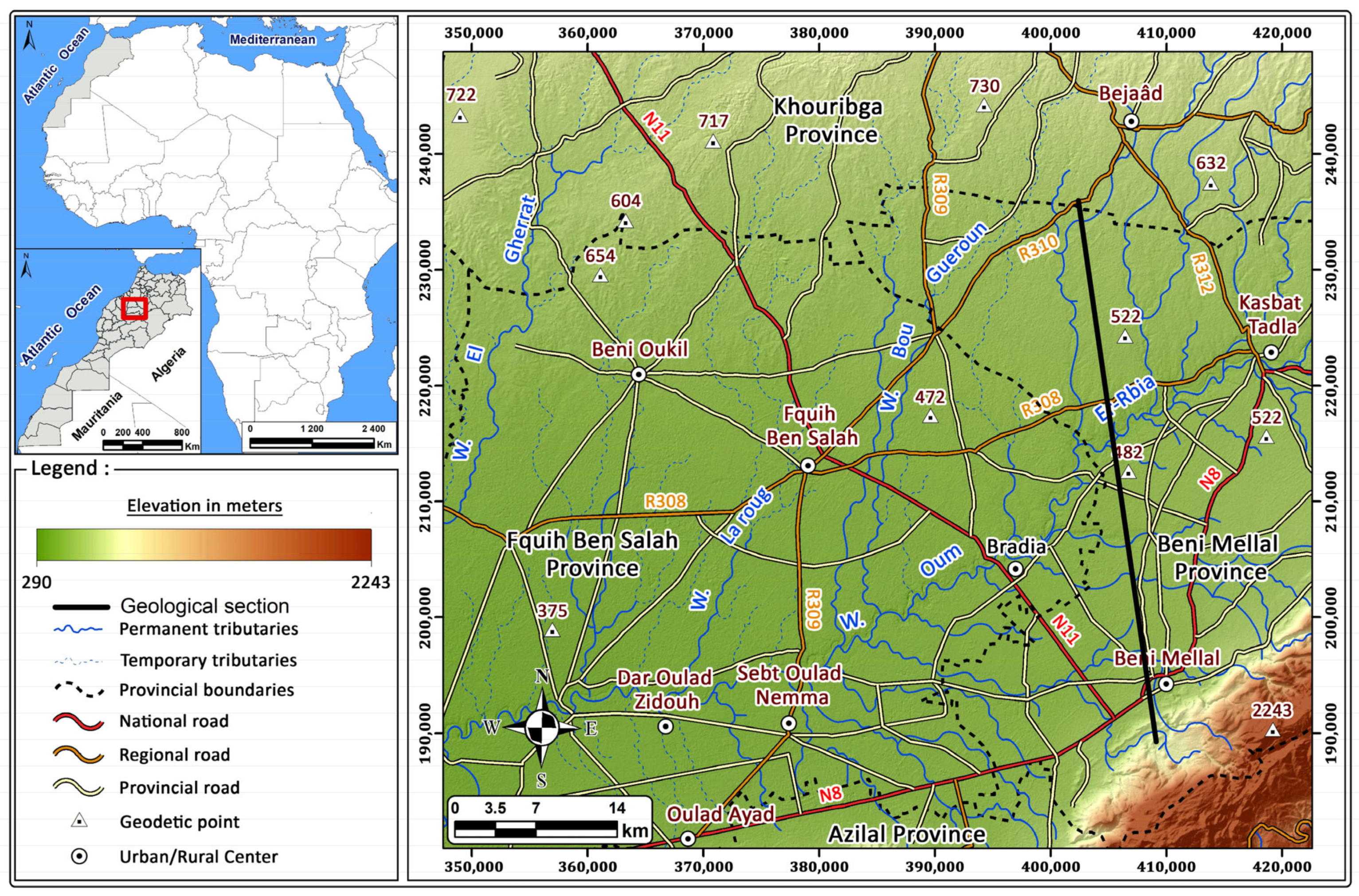


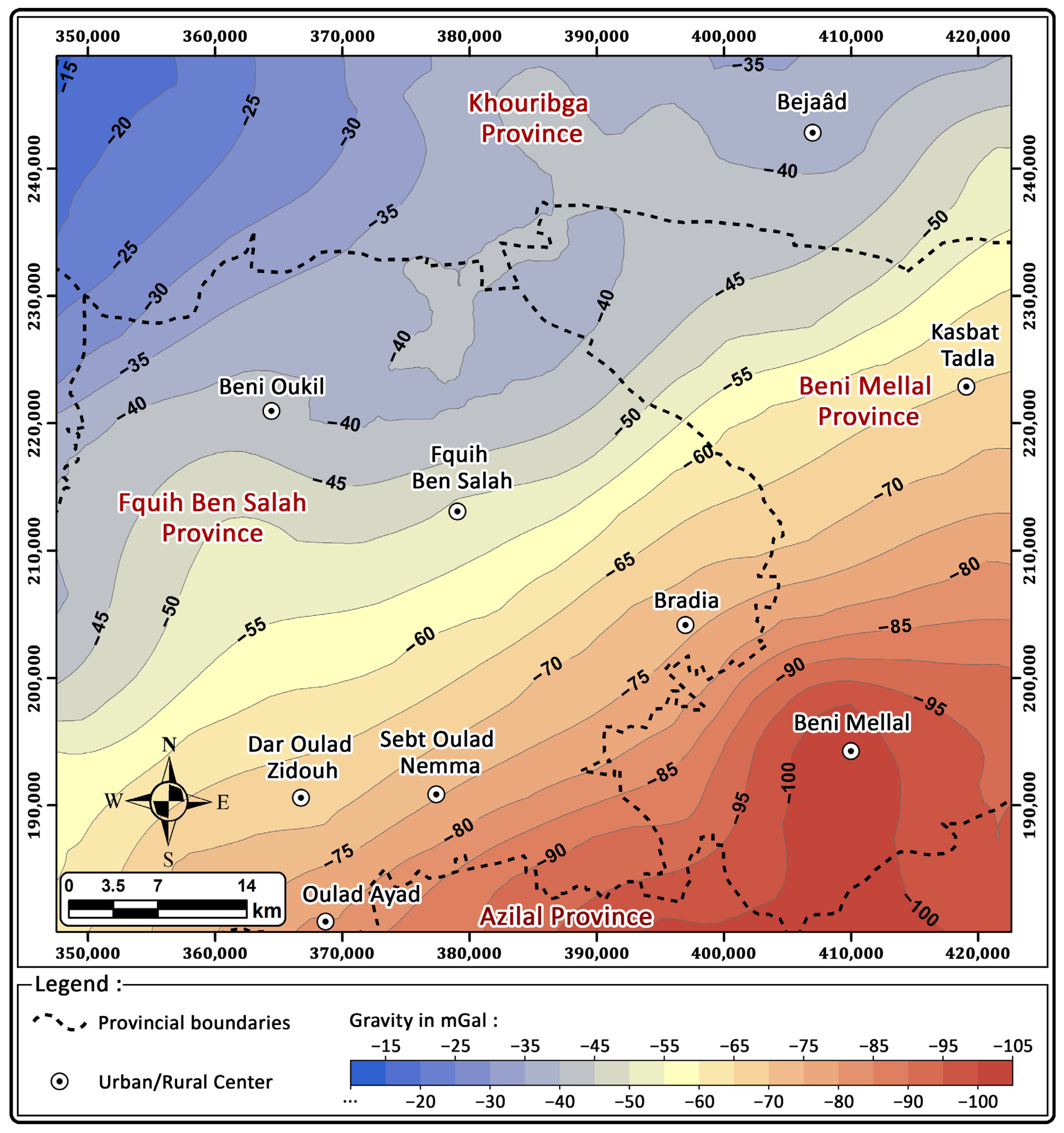
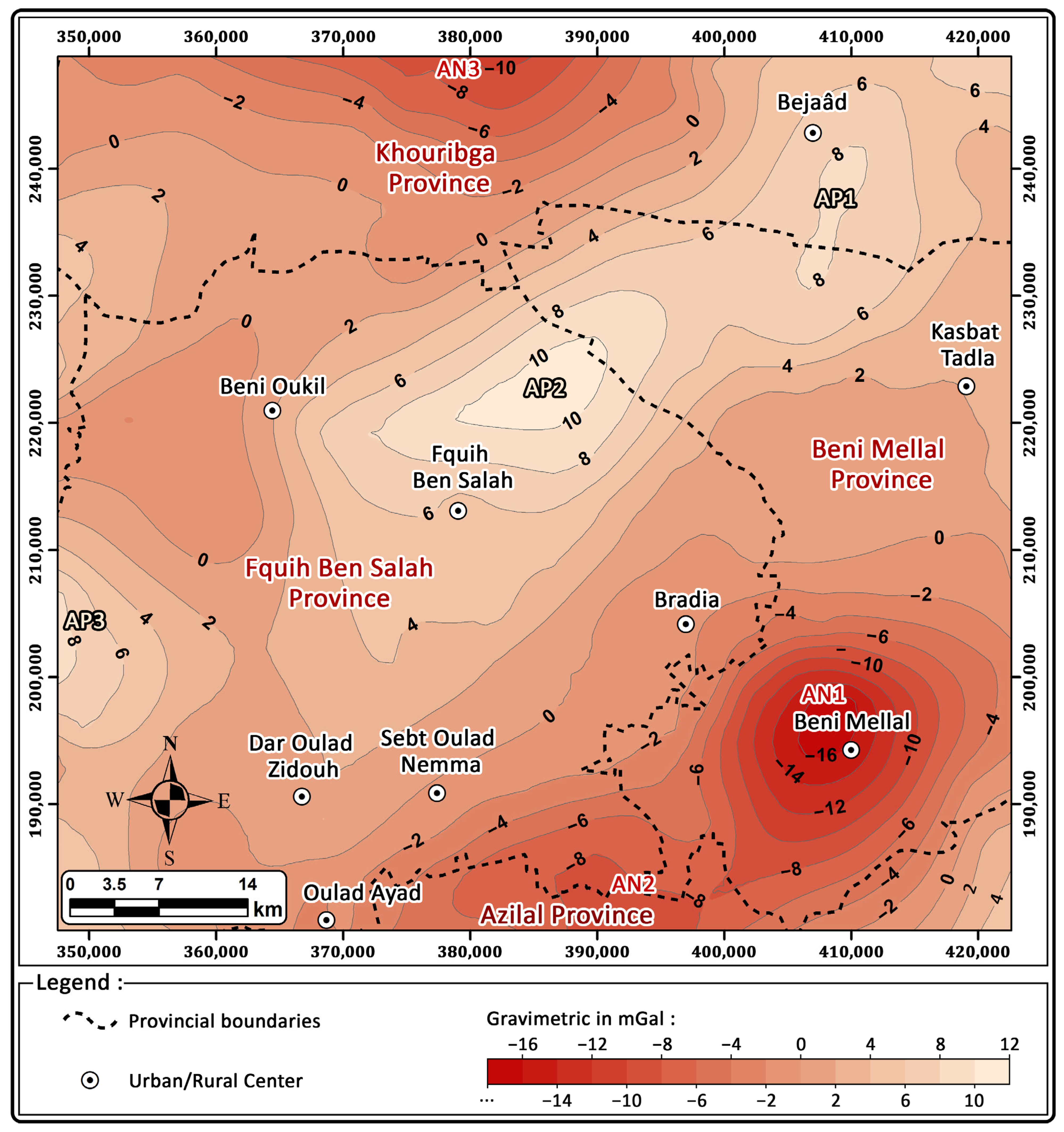
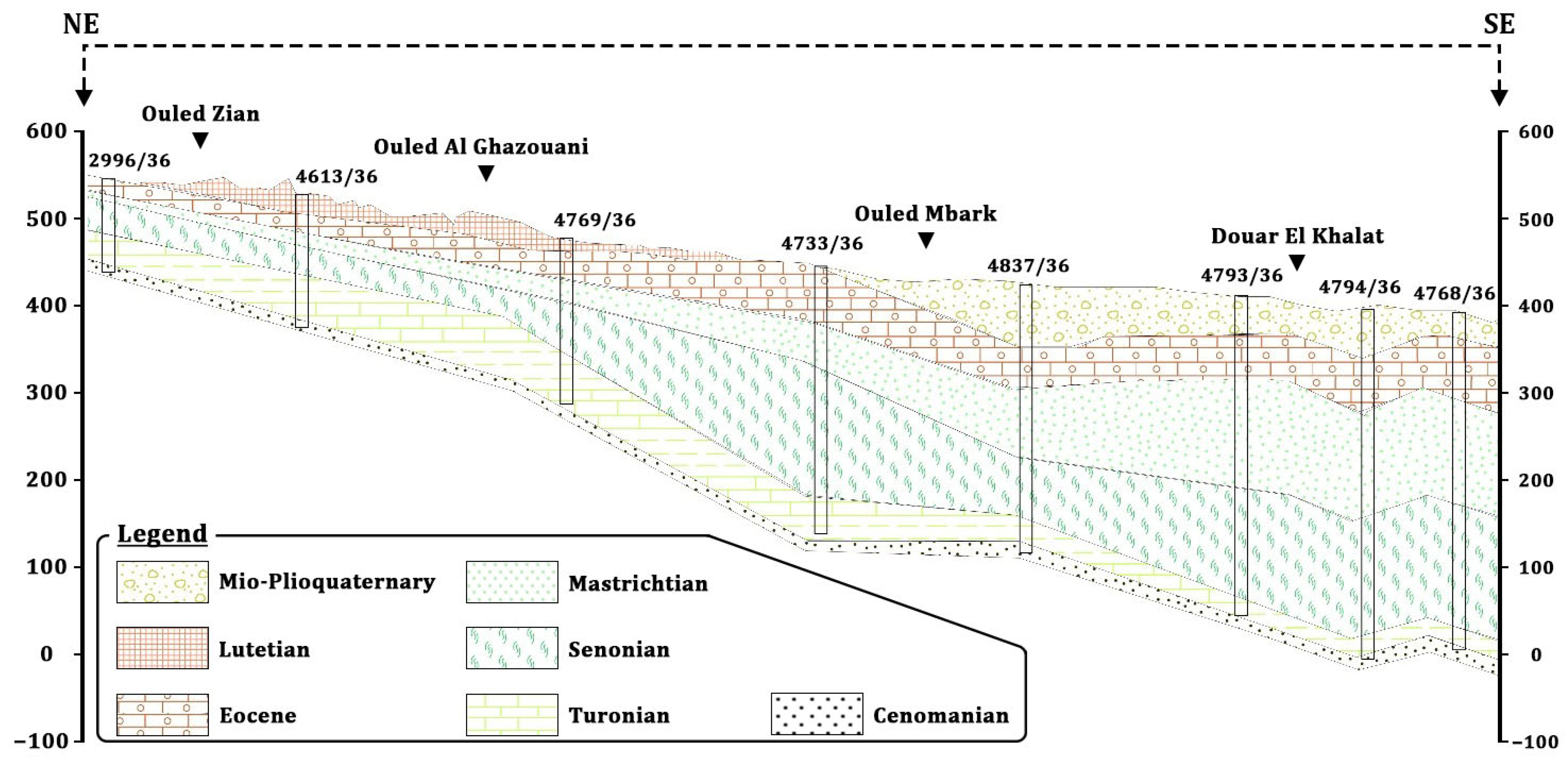

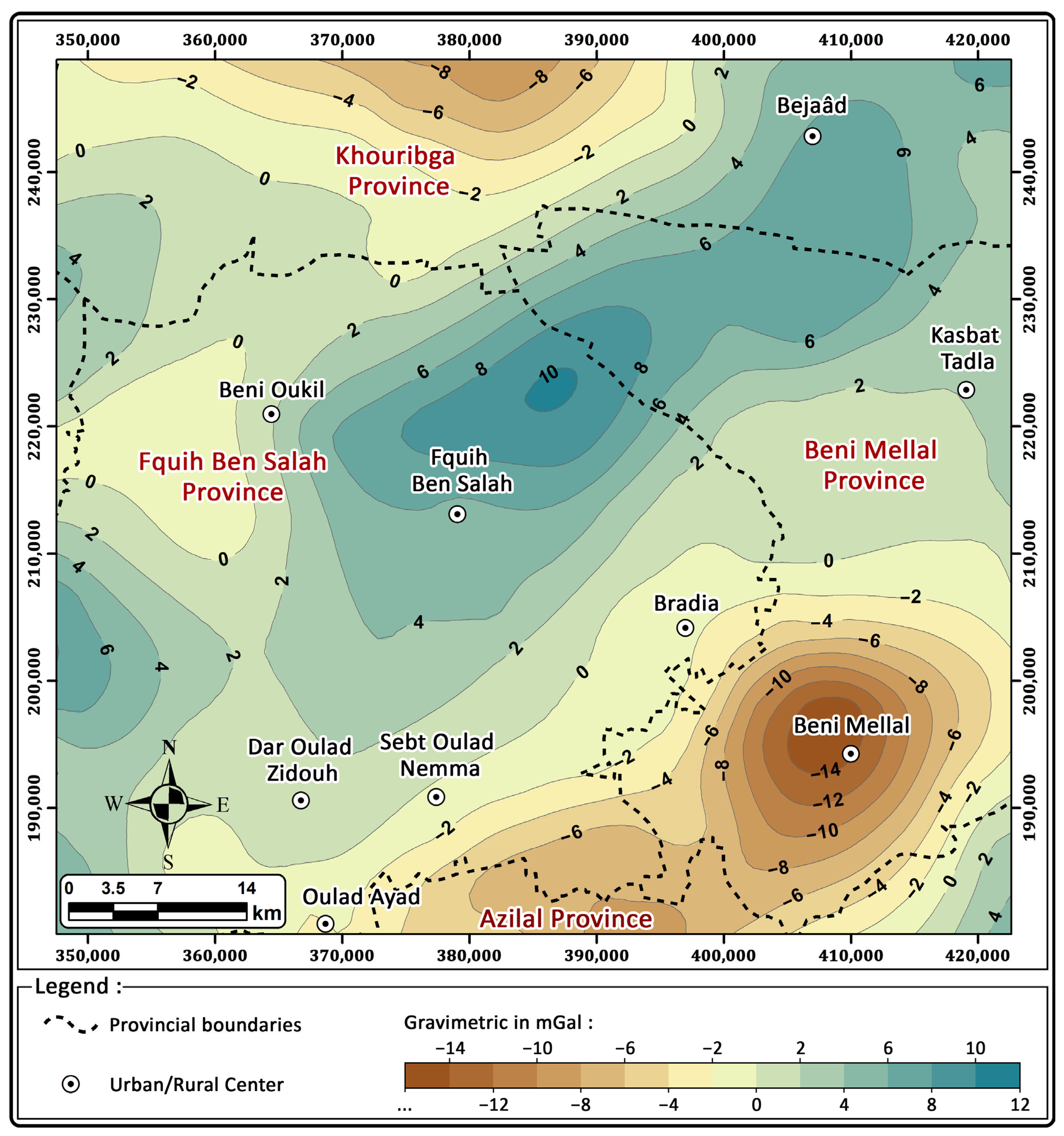
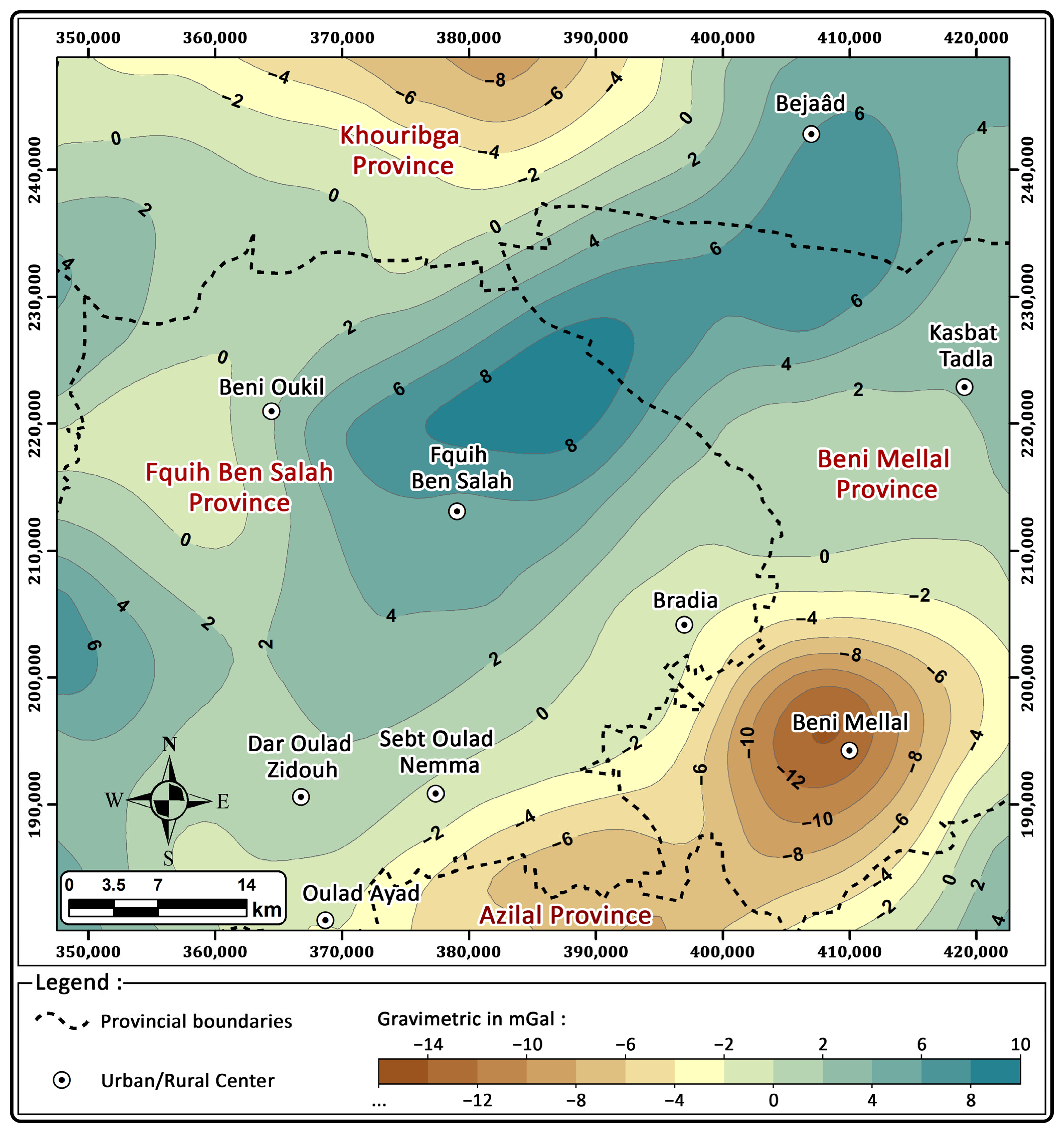
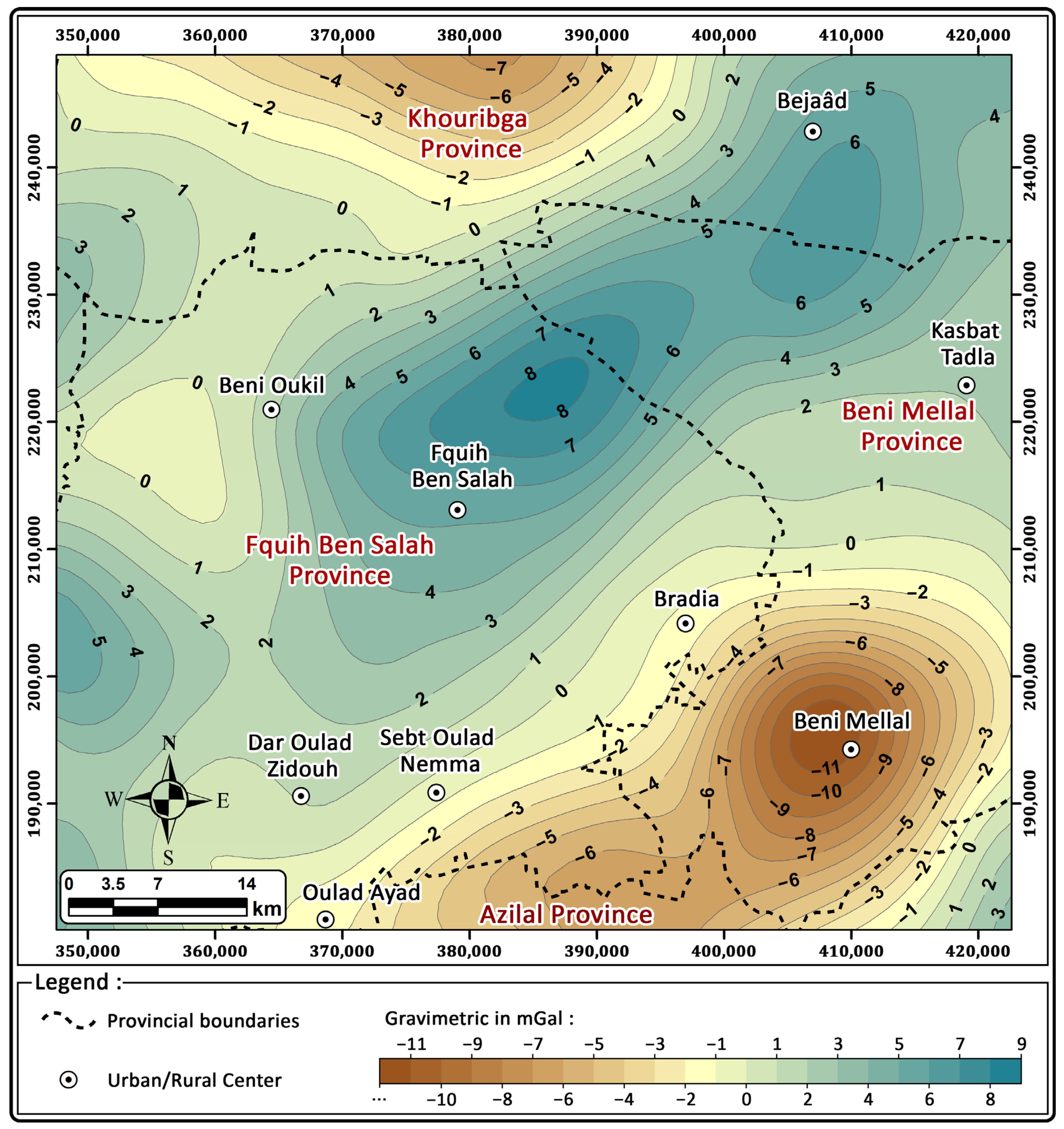
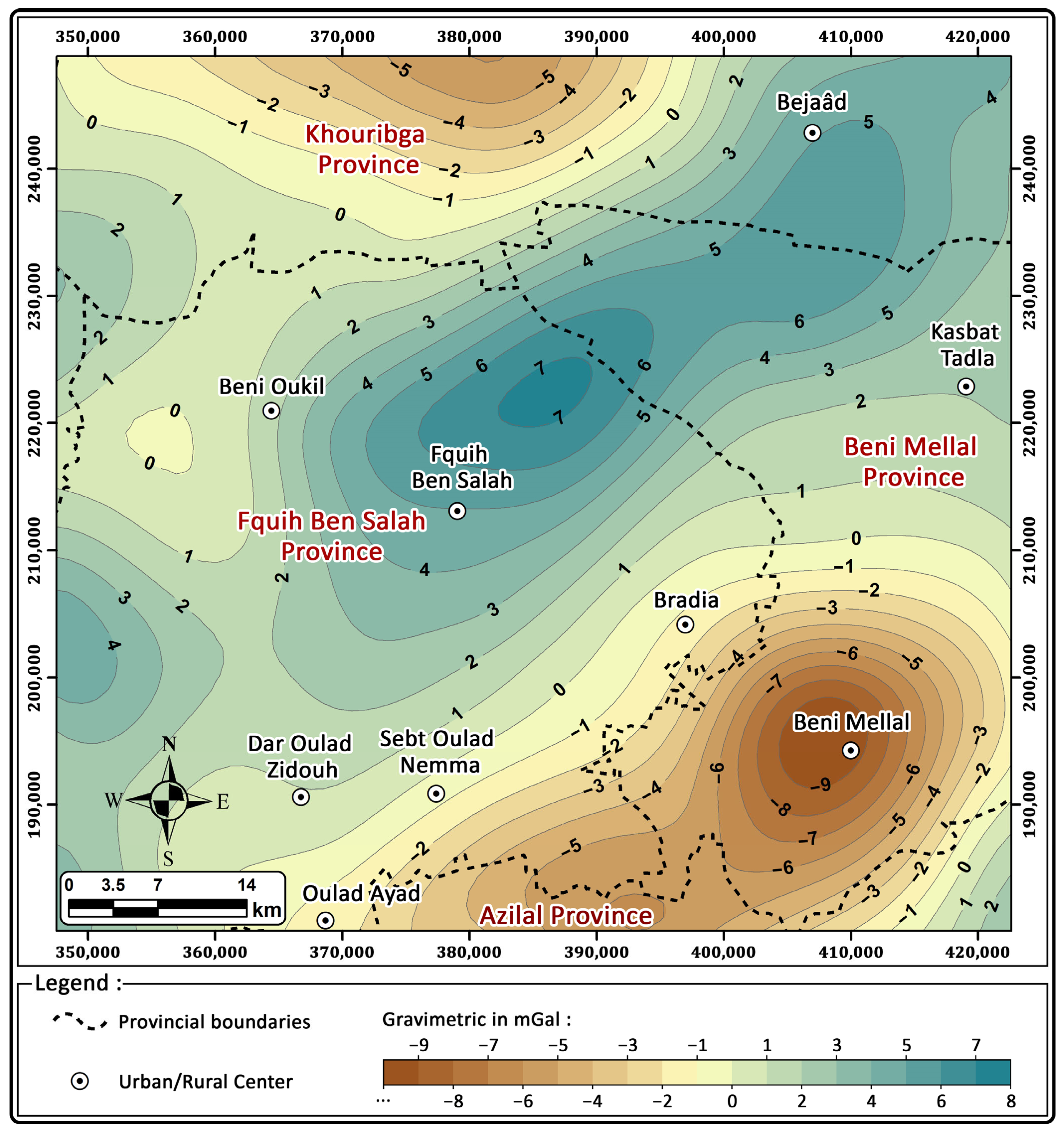
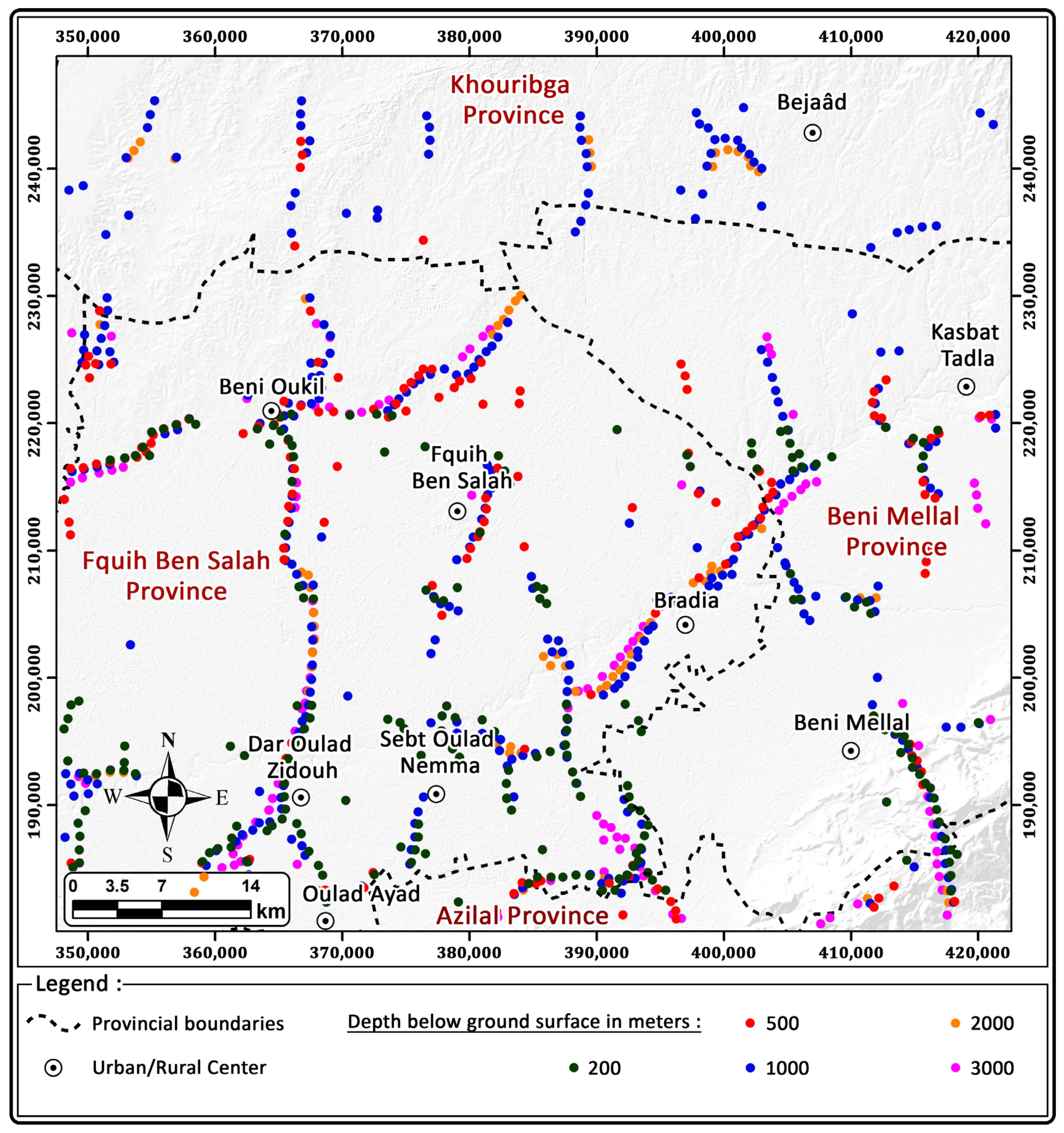
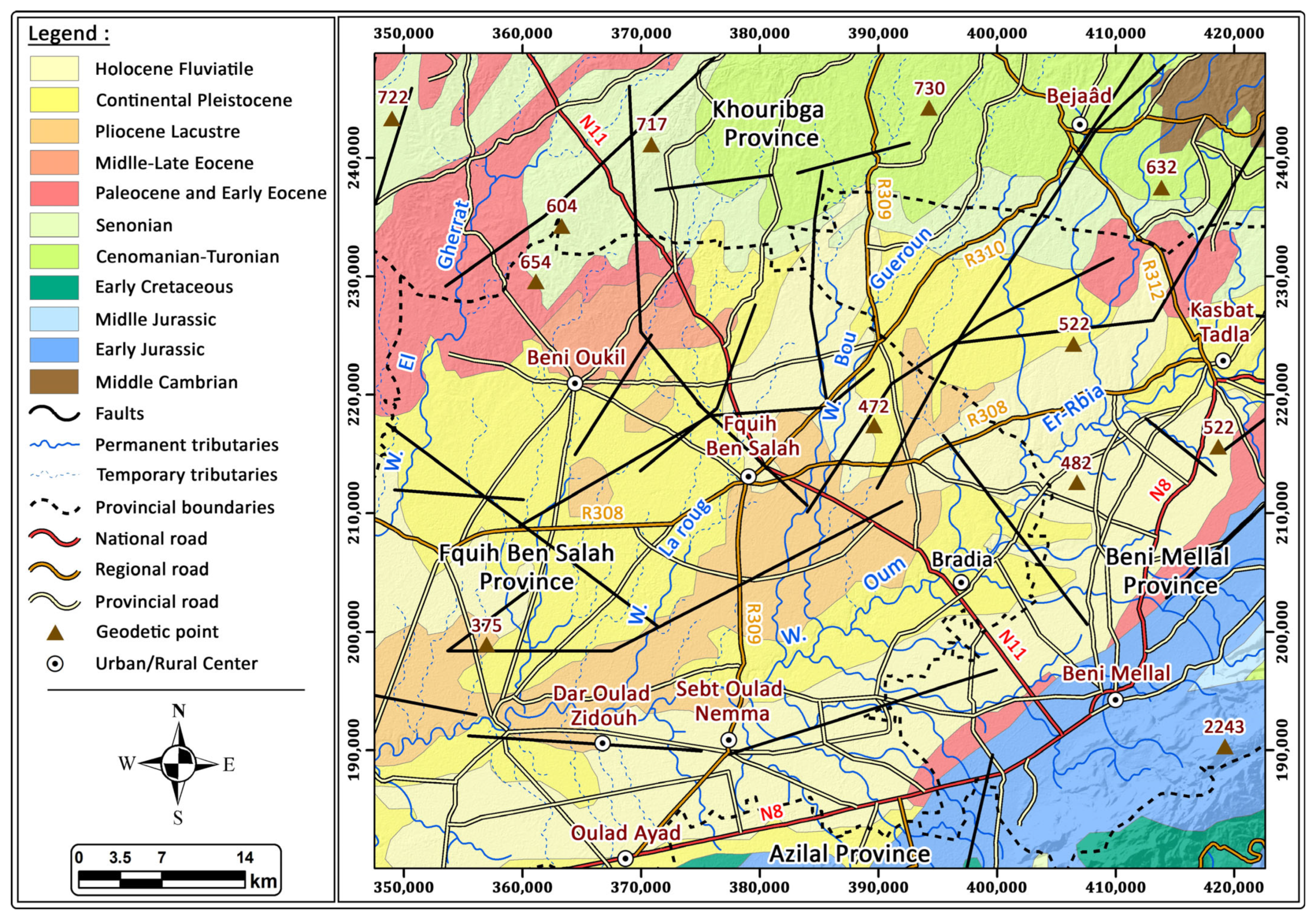
| Anomalies | Direction | Location | Source |
|---|---|---|---|
| AN1 | NE–SW | Béni Mellal | Highly heterogeneous sedimentary infill |
| AN2 | NE–SW | Afourar—Bni Ayat | Thick Mio-Plio-Quaternary deposits |
| AN3 | NE–SW | Oulad Azzouz | Localized sedimentary thickening |
| AP1 | NNE–SSW | Sud-Ouest de Boujad | Uplift of the Paleozoic basement |
| AP2 | NNE–SSW | Oulad Boukhadouj—Ain Kaicher | Uplift of the Paleozoic basement |
| AP3 | NW–SE | Al Khouloute | Shallow Paleozoic basement |
Disclaimer/Publisher’s Note: The statements, opinions and data contained in all publications are solely those of the individual author(s) and contributor(s) and not of MDPI and/or the editor(s). MDPI and/or the editor(s) disclaim responsibility for any injury to people or property resulting from any ideas, methods, instructions or products referred to in the content. |
© 2025 by the authors. Licensee MDPI, Basel, Switzerland. This article is an open access article distributed under the terms and conditions of the Creative Commons Attribution (CC BY) license (https://creativecommons.org/licenses/by/4.0/).
Share and Cite
Didi, S.; El Boute, S.; Hajaj, S.; Hilali, A.; Benmoussa, A.; Bouhachm, S.; Lamine, S.; Najine, A.; Wafik, A.; Soussi, H. Integrating Gravimetry and Spatial Analysis for Structural and Hydrogeological Characterization of the Northeast Tadla Plain Aquifer Complex, Morocco. Geographies 2025, 5, 35. https://doi.org/10.3390/geographies5030035
Didi S, El Boute S, Hajaj S, Hilali A, Benmoussa A, Bouhachm S, Lamine S, Najine A, Wafik A, Soussi H. Integrating Gravimetry and Spatial Analysis for Structural and Hydrogeological Characterization of the Northeast Tadla Plain Aquifer Complex, Morocco. Geographies. 2025; 5(3):35. https://doi.org/10.3390/geographies5030035
Chicago/Turabian StyleDidi, Salahddine, Said El Boute, Soufiane Hajaj, Abdessamad Hilali, Amroumoussa Benmoussa, Said Bouhachm, Salah Lamine, Abdessamad Najine, Amina Wafik, and Halima Soussi. 2025. "Integrating Gravimetry and Spatial Analysis for Structural and Hydrogeological Characterization of the Northeast Tadla Plain Aquifer Complex, Morocco" Geographies 5, no. 3: 35. https://doi.org/10.3390/geographies5030035
APA StyleDidi, S., El Boute, S., Hajaj, S., Hilali, A., Benmoussa, A., Bouhachm, S., Lamine, S., Najine, A., Wafik, A., & Soussi, H. (2025). Integrating Gravimetry and Spatial Analysis for Structural and Hydrogeological Characterization of the Northeast Tadla Plain Aquifer Complex, Morocco. Geographies, 5(3), 35. https://doi.org/10.3390/geographies5030035







